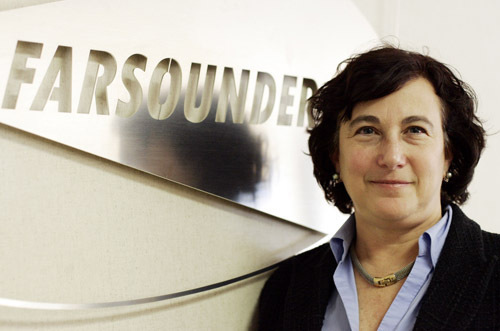This is the seventh in a series of 12 PBN articles focusing on the backgrounds, challenges and successes of some of the area’s most influential and interesting business women. The series began Sept. 12.
Cheryl Zimmerman’s approach to business is to listen to customers and follow her instincts.
Doing so has led her to open new markets for FarSounder Inc., a Warwick-based sonar technology company. After winning the Rhode Island Business Plan Competition in 2002 and receiving some early financing from the Slater Technology Fund, the six-year-old business has turned into a profitable company with customers worldwide.
“In the last year, we more than doubled our product sales,” said Zimmerman, CEO and chairman of the board for FarSounder. “We’re really exploding.”
When the company incorporated it started selling its unique sonar technology – which enables a real-time 3D view of in-water obstacles and sea bottoms for navigation – to yacht owners, then to small cruise ships, passenger vessels and ferries. Those customers continue to comprise the majority of the company’s business.
Since then FarSounder has entered the offshore oil industry’s service-boat market, Zimmerman said, but won’t concentrate on selling the sonar technology to large oil tankers until the company develops a longer-range system for navigation.
The company also has contracts with the U.S. Navy and government projects in Japan, China and Australia.
Much of the new market penetration comes from Zimmerman’s ability to recognize when FarSounder technology can solve a problem in a market, when no one else realizes the market has a relevant connection to the technology, said Matthew Zimmerman, FarSounder co-founder and vice president of engineering. (Matthew is also Cheryl Zimmerman’s son.)
“In order to do that you have to have an intimate understanding of what the technology is, in addition to talking to customers intellectually, understanding their issues … and how it relates to us,” he said. “That’s a really valuable skill for a business leader to have.”
Cheryl Zimmerman came to FarSounder with a master’s degree in mechanical engineering from Tufts University and 20 years of experience running businesses, including a wholesale book company and engineering services company.
She started making connections between FarSounder’s capabilities and new markets after spending a lot of time listening to customers’ needs and wants, both nationally and internationally.
Zimmerman travels extensively to meet with customers face-to-face, to educate them and listen to them, she said.
In addition, before the company launched the sonar, its principals interviewed ship captains to find out what they needed and wanted from new sonar technology.
“They wanted an easy-to-understand graphic interface that you could see the obstacles and you didn’t need a degree to make a decision quickly,” she said. “We had to come up with a way to display advanced information in a simple-to-use manner.”
After developing the 3D graphic display, the principals took the technology back to the captains to get feedback.
Since then, the company has acquired three patents for its FS-3 sonar technology. In September it was awarded a $2 million grant from the U.S. Department of Commerce’s National Institute of Standards and Technology Advance Technology Program to help develop a long range, high speed, navigation-and-obstacle-avoidance sonar.
Zimmerman noted that the Department of Commerce finances “projects that are highly risky, but if successful, will have a major impact on the U.S. economy. They recognized this [technology’s] potential.”
FarSounder’s expanding dealer network also recognizes the potential of the technology. Jody Esfeller, president of Alabama-based E & R Marine Electronics Inc., said he sees the sonar’s potential to provide solutions for large vessels in the petroleum industry, which could make the technology even more lucrative.
“I think there will be a market there for that,” Esfeller said. “Everybody kind of sits back, sees how it works. It might be 5 years before they buy … hopefully it will be a standard piece of equipment.”
Bringing the technology into a conservative marine industry has been a challenge in itself, Zimmerman said. “We worked it from our commercial end, and now we are selling to the Navy and other government agencies,” she said. “Now we’re making the transition to becoming accepted … in some vessels as a type of equipment that’s wanted. We’re not yet required in any vessel.”
With that prospect on the horizon, however, FarSounder is in expansion mode. The company hired a vice president of sales and marketing last year and is looking to hire at least one more employee this year. The company employs 10 people, half of which relocated from out of state.
FarSounder also is looking for a second facility, so that it can move testing of the technology and assembled parts in-house. The company already manufactures all sonar systems in-house, using parts made by vendors in Rhode Island and Southern New England.
“We do all the final assembly, all the prototyping in-house,” Zimmerman said. “Also for intellectual property protection we have all of our [research and development] in-house.”
Zimmerman sees no end to future growth.
Since the cruise ship MS Explorer sank Nov. 23, the company has gotten inquiries about whether the sonar technology detects icebergs. “We know it does work with ice,” Zimmerman said of the proprietary system. “We haven’t done university-type studies of the different types and ranges for icebergs, but our customers have reported that they have used the system to see and avoid icebergs.”
The company also has been developing applications for security initiatives with the U.S. Department of Homeland Security. “Our technology has enabled us to develop a great diver-detection and underwater-threat-detection application,” Zimmerman said.
“I see our technology, the potential of it is to have an impact on the marine industry as great as radar or GPS .… To be able to see obstacles under the water and to see them out to significant distances and actually at environmentally friendly frequency ranges, it’s … very important to the marine industry.” •
No posts to display
Sign in
Welcome! Log into your account
Forgot your password? Get help
Privacy Policy
Password recovery
Recover your password
A password will be e-mailed to you.













